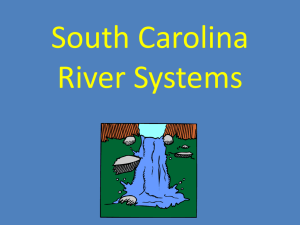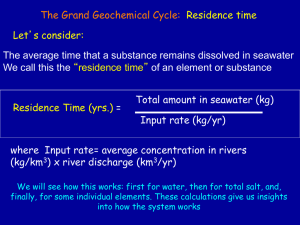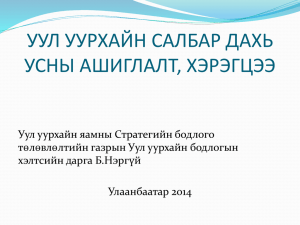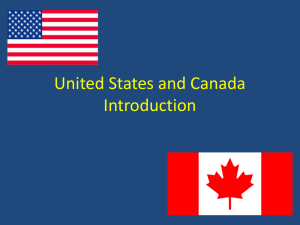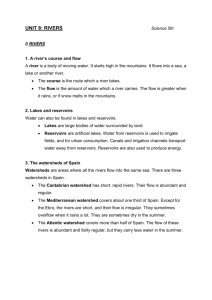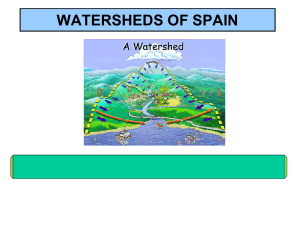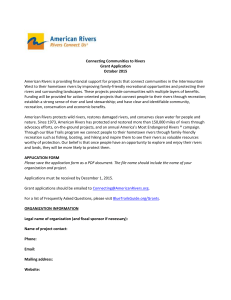Presentation by D. Lettenmaier to Water as a Source of Conflict and
advertisement
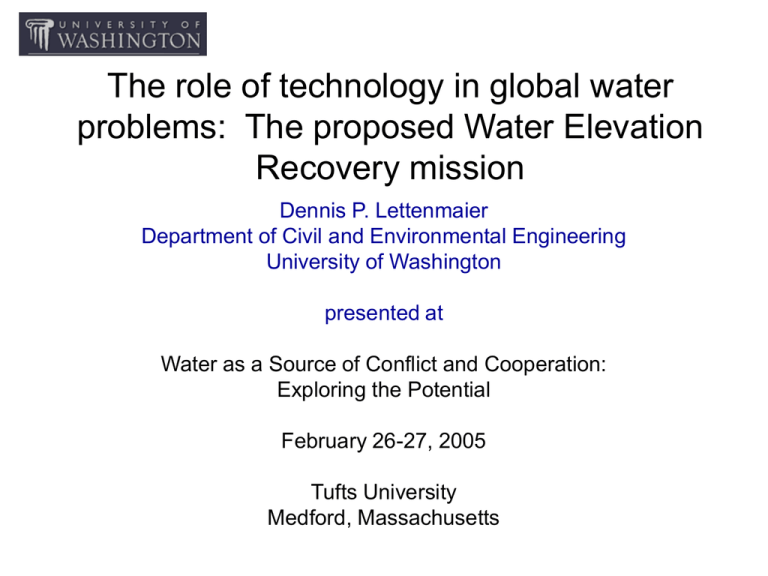
The role of technology in global water problems: The proposed Water Elevation Recovery mission Dennis P. Lettenmaier Department of Civil and Environmental Engineering University of Washington presented at Water as a Source of Conflict and Cooperation: Exploring the Potential February 26-27, 2005 Tufts University Medford, Massachusetts Outline • • • • Basic facts on global water usage Reservoir Impoundments TransBoundary Issues How a surface water mission would help A thumbnail sketch of global water issues Approximately 25,000 people die each year due to floods Drought losses globally have exceeded $300B over the last decade More than 1.2 billion have inadequate drinking water (poor quality, insufficient quantity) Twice that many (2.5 billion) lack adequate sanitation facilities. Approximately 10% of the annual discharge of the world’s rivers is used consumptively, and several major continental rivers (e.g., Colorado, Nile, Yellow) are dry for at least part of the year The quality of many of the world’s rivers has been seriously degraded by a combination of pollution, land cover change, dams, and other factors Many, if not most, of these problems are not amenable to technological solutions – but some are One such example is the acquisition of data about river discharge, and the storage of water in reservoirs, lakes, and wetlands Why do we care about streamflow? • Rivers are the earth’s arteries • Rivers are a primary source of water for human consumption, food production, transportation, and many other uses • Riparian corridors (including wetlands) are extraordinarily productive and diverse biologically • Much of the world’s population lives in flood plains • Rivers also pose major hazards to human life and well being (due to both floods and droughts) • Domestic consumptive use (U.S.) is ~200-250 liters/day • Compare with drinking water requirement (about 5 l/day). U.S. domestic consumption has declined slightly over the last two decades. Much of difference between potable water requirement and use is sanitation, laundry, etc. • Industrial requirement in developed world is of same order as domestic • Total water withdrawals are about 6000 km3/yr • Compare with global (land) precip ~150,000 km3/yr (or global runoff ~0.4 x runoff) The Global Picture ● Water resource issues will have large effects on many of the world’s major decisions in the next 50 years. ● 1 billion people live on less than $1/day. ● More than 1.2 billion have inadequate drinking water (poor quality, insufficient quantity, but still priced beyond the means of the poorest), and twice that many (2.5 billion) lack sanitation facilities. ● Poorly handled: could result in wars and will result in premature deaths, poor quality of life for many, and widespread degradation of aquatic ecosystems. ● Well handled: opportunities for scientific and political creativity, international collaboration, promoting cooperation rather than discord. Widespread efficiency improvements are possible, in all sectors • 1930s: 200 tons of water per ton of steel • 1980s: 20-30 tons of water per ton of steel • 2002: 2-3 tons of water per ton of steel • Agricultural water use can drop and yields can increase with better irrigation technology. • Essentially, industrialized nations have improved their water usage, but what about developing nations? • And population growth is a water management problem… next 3 slides Unmet Basic Human Needs for Water • 1.1 billion people lack access to adequate drinking water (mostly in Africa and Asia). • 2.4 billion people lack access to adequate sanitation services. • 2.2 to 5 million die annually from preventable water-related diseases. – What are the implications for global water management and assessment? For 2025, Relative to 1985 • Ability to globally forecast freshwater availability is critical for population sustainability. • Water use changes due to population are more significant than climate change impacts. • Predictions also demonstrate the complications to simple runoff predictions that ignore human water usage (e.g., irrigation). Vörösmarty, C.J., P. Green, J. Salisbury, and R.B. Lammers, Global water resources: Vulnerability from climate change and population growth, Science, 289, 284-288, 2000. Global Reservoir Database Location (lat./lon.), Storage capacity, Area of water surface, Purpose of dam, Year of construction, … 13,382dams, Global Water System Project IGBP – IHDP – WCRP - Diversitas Global Water System Project IGBP – IHDP – WCRP - Diversitas Human modification of hydrological systems Historic Naturalized Flow Estimated Range of Naturalized Flow With 2040’s Warming Regulated Flow Figure 1: mean seasonal hydrographs of the Columbia River prior to (blue) and after the completion of reservoirs that now have storage capacity equal to about one-third of the river’s mean annual flow (red), and the projected range of impacts on naturalized flows predicted to result from a range of global warming scenarios over the next century. Climate change scenarios IPCC Data and Distribution Center, hydrologic simulations courtesy of A. Hamlet, University of Washington. Reservoir construction has slowed. 800 . 700 Number of Reservoirs 600 500 Australia/New Zealand Africa Asia Europe Central and South America North America 400 300 200 100 0 Up to 1901- 1911- 1921- 1931- 1941- 1951- 1961- 1971- 1981- 19901900 1910 1920 1930 1940 1950 1960 1970 1980 1990 1998 All reservoirs larger than 0.1 km3 Case study – Ganges – Brahmaputra River flood forecasting Source: Jorgensen and Host-Madsen, 1997 Brahmaputra River 25-day lead forecasts using experimental ECMWF long-lead precipitation forecasts Visual courtesy Tony Hollingsworth, ECMWF • Question: why not just use discharge at upstream gauges in India? • Answer: Because India won’t release the data (at least in anything close to realtime) Flooding Issues • Flooding imposes clear dangers, but the lack of water heights and inundation mapping during the passage of the flood wave limit important hydraulic modeling that would otherwise predict the zones of impact. • Essentially, can we predict flooding hazards which could be used to understand the consequences of land use, land cover, and climatic changes for a number of globallysignificant, inhabited floodplains? Prague Estimated Costs: $1.9 Billion Over 100 dead in Europe, alone Black Sea Kentucky China These are the floods from 2002, alone! India From the standpoint of global water issues, what would be the impact of the proposed WatER mission? • Freely available data on water storage for water bodies larger than ~1 km • Capability to produce river discharge estimates for many rivers with width > ~50-100 m • Major implications for the ability to predict floods and droughts globally • Elimination of “competive advantage” of upstream countries in trans-boundary rivers • Implications for global markets (especially food) Possible role and implications of a global surface water mission • Free and open exchange of global hydrologic data (which presently does not exist) • Understanding how reservoirs are operated (presently there is no coherent data base for reservoir storage) • Water and human health (2 billion incidences of waterborne diseases per year globally!)




